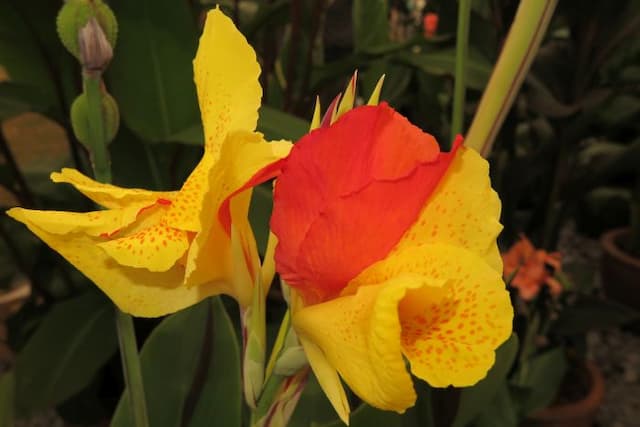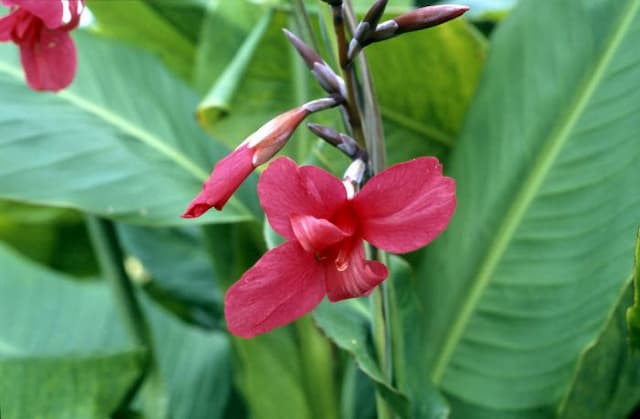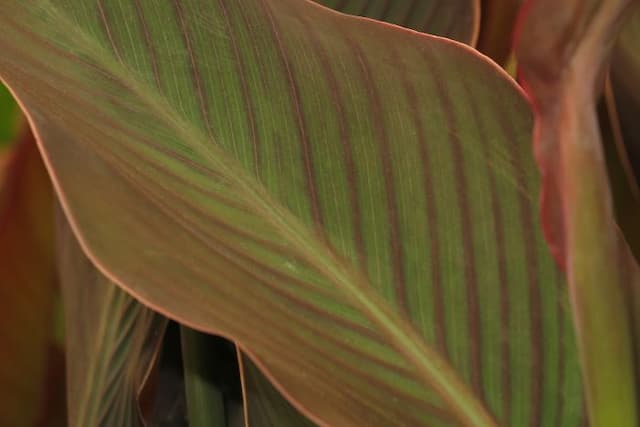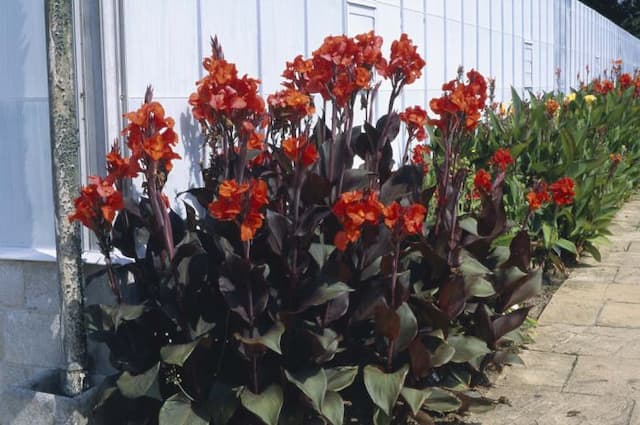Canna Lily Canna 'Amundsen'

ABOUT
Canna 'Amundsen' is a flowering perennial known for its vibrant and exotic appearance. This plant presents a lush display of large, broad leaves that often exhibit a tropical look with a rich green hue. The bold foliage may sometimes have hints of bronze or burgundy, depending on the variety. The most striking aspect of the Canna 'Amundsen' is its flowers, which stand out against the foliage with their vivid colors. The blossoms display a fiery red or deep orange shade, making them a center of attraction in any garden. These flowers typically take on a classic Canna form, resembling an iris, and they have a flared shape that contributes to the showy display. The petals have a somewhat ruffled look, which adds to the overall exotic charm of the plant. Completing the tropical theme are the seed pods that form after blooming. These pods are usually small, round, and green when young, turning to a brownish color as they mature. The entire plant radiates a lush, tropical vibe, making it a popular choice for gardeners who want to add a splash of color and exotic flair to their landscapes. Despite the size omission, the Canna 'Amundsen' carries a presence that can be a focal point in garden design, primarily due to its striking flowers and attractive foliage.
About this plant
 Names
NamesSynonyms
Canna Lily, Canna, Indian Shot
Common names
Canna 'Amundsen'.
 Toxicity
ToxicityTo humans
Canna lilies are not known to be toxic to humans. They do not contain substances that are considered poisonous upon ingestion. Therefore, eating parts of the Canna 'Amundsen' is unlikely to cause any symptoms of poisoning. However, as with any non-food plant, individual allergic reactions or sensitivities are always possible, and it is not advisable to eat this or any ornamental plant.
To pets
Canna lilies are generally considered non-toxic to pets such as dogs and cats. The Canna 'Amundsen', like other varieties of Canna lilies, does not have a reputation for being poisonous. However, ingestion of plant material can sometimes lead to mild gastrointestinal upset in some pets due to the fibrous nature of the plant or due to non-toxicity-related sensitivities. Symptoms might include vomiting or diarrhea, but significant toxicity is not expected.
 Characteristics
CharacteristicsLife cycle
Perennials
Foliage type
Deciduous
Color of leaves
Green
Flower color
Red
Height
3-4 feet (0.9-1.2 meters)
Spread
1-2 feet (0.3-0.6 meters)
Plant type
Bulb
Hardiness zones
7
Native area
Tropical Americas
Benefits
 General Benefits
General Benefits- Attractive Foliage: Canna 'Amundsen' has broad, tropical-looking leaves that add lushness and a vibrant green backdrop to gardens.
- Vivid Blooms: The plant is known for its striking flowers, which can enhance the visual appeal of any space.
- Pollinator-friendly: Its flowers attract pollinators like bees and butterflies, contributing to the health of the local ecosystem.
- Easy to Grow: It is relatively easy to care for, requiring minimal maintenance once established.
- Fast Growing: They grow quickly, providing a near-instant impact in landscaping projects.
- Drought Tolerant: Once established, Canna 'Amundsen' can tolerate periods of low water, making it suitable for xeriscaping or drought-prone areas.
- Versatility: Suitable for container gardening, borders, or as a focal point in floral arrangements.
 Medical Properties
Medical PropertiesThis plant is not used for medical purposes.
 Air-purifying Qualities
Air-purifying QualitiesThis plant is not specifically known for air purifying qualities.
 Other Uses
Other Uses- Canna can be used as a natural pest repellent when planted in vegetable gardens, as it may help deter certain insects and small animals due to its large leaves.
- The rhizomes of Canna can be processed into a starch, known as achira, which is used in the production of biodegradable plastics.
- Canna leaves can be used as a green mulch, providing nutrients to the soil as they decompose due to their nitrogen content.
- Canna can be integrated into greywater treatment systems as they have a capacity to absorb excess nutrients and contaminants.
- The fibrous stems of Canna can be used in the manufacture of paper, offering a non-wood-based alternative for paper production.
- Fresh Canna shoots are edible and can be consumed when they are young, providing a unique flavor to salads and stir-fries.
- Dried Canna leaves can be crafted into eco-friendly plates and utensils, which are biodegradable and compostable.
- Canna flowers can be used to create natural dyes for textiles, providing a range of vibrant colors.
- In permaculture design, Canna is often used as a windbreak or privacy screen due to its tall and dense growth habit.
- The large, decorative leaves of Canna can be used in floral arrangements or as natural art material for crafting.
Interesting Facts
 Feng Shui
Feng ShuiThe Canna is not used in Feng Shui practice.
 Zodiac Sign Compitability
Zodiac Sign CompitabilityThe Canna is not used in astrology practice.
 Plant Symbolism
Plant Symbolism- Love: The Canna plant, often associated with the tropical and exotic, symbolizes a heated and passionate love.
- Beauty: With its bold, colorful flowers, the Canna is seen as a symbol of striking beauty.
- Pride: The tall and upright growth of the Canna embodies pride and confidence.
- Change: As the Canna goes through a lifecycle of growth, bloom, and dormancy, it represents transformation and change.
 Water
WaterCannas, including the Canna 'Amundsen', demand consistent moisture and should be watered thoroughly once the top inch of soil feels dry. Typically, this could mean watering once a week, but during hot or windy weather, you might need to water every few days. When watering, avoid getting water on the foliage, which can lead to fungal diseases; instead, direct water to the base of the plant. It's important to ensure the plant receives a deep watering, which might mean using up to 2 gallons per plant, depending on the size and the environmental conditions.
 Light
LightCannas thrive in full sun, requiring at least six hours of direct sunlight daily. The Canna 'Amundsen' will perform best in a location that receives unobstructed sunlight throughout most of the day. If planted indoors, a south-facing window is the ideal spot for it to ensure it gets enough light.
 Temperature
TemperatureThe Canna 'Amundsen' prefers warm temperatures and grows best between 60°F and 90°F. Frost is detrimental to cannas, so ensure the plant is protected or brought indoors if temperatures approach the minimum threshold of 50°F. Ideal growth is seen when night temperatures do not drop below 60°F.
 Pruning
PruningPruning Canna 'Amundsen' is primarily done to remove spent flowers and damaged or diseased leaves, which encourages more blooms and maintains plant health. Cut back foliage to the ground level in late fall after leaves have died back, usually after the first frost. During the growing season, deadhead flowers as they fade and prune as necessary to keep the plant looking its best.
 Cleaning
CleaningAs needed
 Soil
SoilThe best soil mix for Canna lilies, including the 'Amundsen', is a rich, well-draining soil with a pH of 6.0 to 6.5. A mix composed of loamy soil, compost or well-rotted manure, and some sand or perlite to improve drainage will support healthy growth.
 Repotting
RepottingCanna lilies generally need to be repotted every 2 to 3 years, or when they outgrow their current container. However, since they are often grown as annuals, they may not require repotting if renewed each season.
 Humidity & Misting
Humidity & MistingCanna lilies thrive in moderate to high humidity levels but are adaptable to typical outdoor conditions. Aim for 40-70% humidity for optimal growth if growing them indoors.
 Suitable locations
Suitable locationsIndoor
Ensure bright light, warm temps, and space for growth.
Outdoor
Choose sunny spot, protect from strong winds, enrich soil.
Hardiness zone
7-11 USDA
 Life cycle
Life cycleCanna 'Amundsen', commonly known as Canna Lily, begins its life cycle as a rhizome, which germinates in warm soil to produce shoots that grow into lush foliage. The foliage stage is characterized by large, paddle-shaped leaves that often have colorful streaks or patterns, making the plant attractive even before it flowers. Following the vegetative stage, the Canna Lily enters its flowering stage in the summer, where it produces vibrant blooms that can be red, orange, yellow, or pink atop tall stalks, attracting pollinators like bees and hummingbirds. After pollination, the flowers are followed by seed pods that dry and split open to release seeds, although gardeners more commonly propagate Cannas through division of the rhizomes rather than by seed. As the growing season ends, in cooler climates the foliage dies back to the ground with the onset of frost, and the rhizomes can be overwintered underground or stored in a frost-free area to be replanted the next spring. Each year, the rhizomes can be divided in early spring to produce new plants, thereby continuing the life cycle of the Canna Lily.
 Propogation
PropogationPropogation time
Spring to Summer
The most popular method of propagating Canna 'Amundsen', commonly known as Canna Lily, is through division of its rhizomes. This is typically done in the spring as the plant emerges from dormancy. To propagate, gardeners should carefully dig up the clumps of rhizomes after the last frost, making sure not to damage them. With a clean and sharp knife, the rhizomes are then cut into sections, ensuring each section has at least one eye, or growth point. These sections are then planted about 3 to 4 inches (approximately 7.5 to 10 centimeters) deep in well-draining soil, spaced about 1 to 2 feet (30 to 60 centimeters) apart to allow for ample growth. Water the newly planted rhizomes thoroughly to help establish them. The warm temperature and moist soil of spring provide an ideal environment for the rhizomes to take root and thrive.









